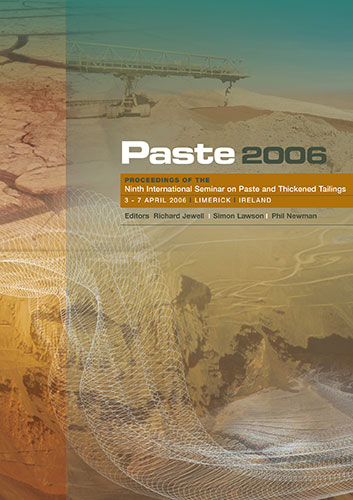Self-Desiccation of Cemented Paste Backfill and Implications for Mine Design

|
Authors: Grabinsky, M; Simms, P |
DOI https://doi.org/10.36487/ACG_repo/663_28
Cite As:
Grabinsky, M & Simms, P 2006, 'Self-Desiccation of Cemented Paste Backfill and Implications for Mine Design', in R Jewell, S Lawson & P Newman (eds), Paste 2006: Proceedings of the Ninth International Seminar on Paste and Thickened Tailings, Australian Centre for Geomechanics, Perth, pp. 323-332, https://doi.org/10.36487/ACG_repo/663_28
Abstract:
The hydraulic and mechanical properties of Cemented Paste Backfill (CPB) that are of principle interest in Geomechanical Mine Design include rheology, suction (the Soil Water Characteristic Curve or Water Retention Curve), permeability, stiffness, and static and dynamic strength (including resistance to liquefaction). All of these properties change as the binder in the CPB hydrates. In some, and perhaps most, mining applications the rate of hydration, and therefore the rate of hydraulic and mechanical property change, occurs on a time scale comparable to the rate of CPB delivery to and filling of the stope. This means that the CPB’s properties are evolving even as it is being deposited and overprinted. This fact can have serious implications for how we interpret total stress cell results, how arching develops both within the stope and across the fill barricades, how fill barricades are designed and constructed, and how we evaluate the CPB’s ability to carry its own self-weight during filling (i.e., resistance to static liquefaction during filling) and subsequent mining (i.e., resistance to dynamic liquefaction during blasting in proximity to recent fills). This paper begins by considering some initially unexpected results from an in situ investigation that illustrates the interaction between rate of binder hydration and rate of stope filling. The framework for conducting tests to evaluate CPB’s evolving hydraulic and mechanical properties is then considered. Some initial test results involving static monotonic and cyclic loading of CPB are then reviewed, and the mine design implications of these test results are considered. The conclusions arising from this work are not yet meant to be used for practical design, but rather point to the extensive research and development that is still required before we can rationally carry out optimized design of CPB fills and their barricades.
References:
Acker, P. (2004) Swelling, shrinkage and creep: a mechanical approach to cement hydration. Materials and Structures: Concrete
Science and Engineering, 37 pp. 237-243.
Godbout, J., Bussière, B., Aubertin M., Balem, T. and Benzaazoua, M. (2004) Évolution des propriétés de rétention d’eau des
remblais miniers cimentés en pâte durant le curage. Proceedings of the 57th Canadian Geotechnical Conference, Quebec City.
Grabinsky, M.W., Simms, P., Bawden, W.F. and le Roux, K. (2005) In situ properties of cemented paste backfill and implications for
mine design. Symposium 2005 on Mines and the Environment, Rouyn-Noranda.
Kim, J.-K. and Lee, C.-S. (1999) Moisture diffusion of concrete considering self-desiccation at early ages. Cement and Concrete
Research, 29 pp. 1921-1927.
le Roux, K., Grabinsky, M.W. and Bawden, W.F. (2002) Laboratory analysis of consolidation and hydration of cemented paste
backfill. Proceedings of the 55th Canadian Geotechnical Conference, Niagara Falls.
le Roux, K., Bawden, W.F. and Grabinsky, M.W. (2004) Liquefaction analysis of early age cemented paste backfill. Eighth
International Symposia on Mining with Backfill (Minefill 2004), Beijing.
le Roux, K., Grabinsky, M.W. and Bawden, W.F. (2005) Consolidation and fabric development in cemented paste backfill. Trans.
Instn Min. Metall. (Sect. A:Min. Technol.), in publication.
332 Paste2006,Limerick,Ireland
Self-DesiccationofCementedPasteBackfillandImplications… M.Grabinsky,P.Simms
© Copyright 2025, Australian Centre for Geomechanics (ACG), The University of Western Australia. All rights reserved.
View copyright/legal information
Please direct any queries or error reports to repository-acg@uwa.edu.au
View copyright/legal information
Please direct any queries or error reports to repository-acg@uwa.edu.au